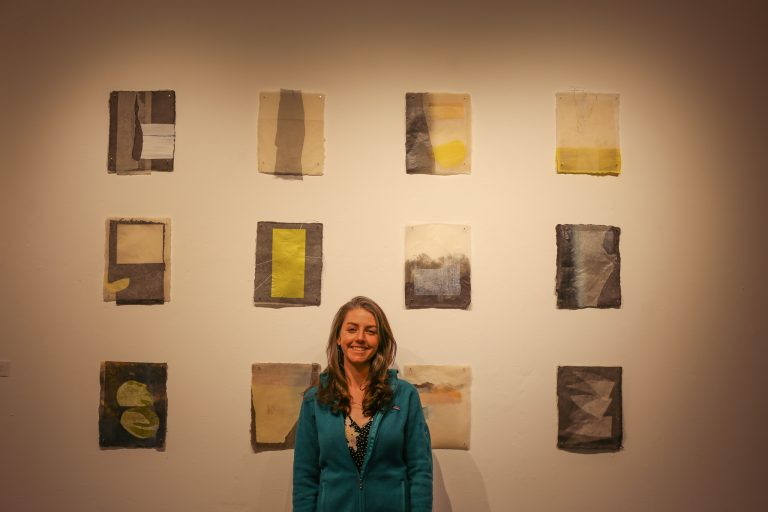
Kendall Murphy
Staff Writer
A new exhibit opened last Monday at the Glass Box Gallery in Building 534 of the University of California, Santa Barbara Art Department.
“Instinct is Memory in Disguise” features handmade paper, prints, and woodworkings by 2nd year MFA student Lucy Holtsnider.
Her art is inspired by a journey she took across the East Coast on a year long sailing program merging science and art called Climate Odyssey. Along her travels, Holtsnider observed and documented the effects of climate change. Each piece embodies specific locations to which Holtsnider has traveled.
“Instinct is Memory in Disguise” marries scientific climate research with compelling handmade art that constructs a unique portrait of global warming.
The title of the exhibit speaks to the process of papermaking and how memory informs seemingly instinctual decisions when making art. The phrase comes from “The Elements of Typographic Style” by Robert Bringhurst, in which he asserts that although new designers may construct designs based solely on instinct, they are guided by their previous life experiences.
As Holtsnider explained in an interview with The Bottom Line, “They’ve [New designers] seen things correctly laid out in their lives, it’s in sort of an archive in their mind. This really struck me as I was thinking about places I’ve traveled in my life”.
Holtsnider’s climate odyssey began in Manitowoc, Wisconsin and covered over 3,000 miles along the East Coast, all while sailing in a wooden catamaran. She was accompanied by a hydrologist, who researched environmental shifts and changes in water systems at their different stops during the journey. The team also created an interactive map of the places they visited, which allows users to learn about how climate change has affected specific locations on the coast.
The art she creates is a new way of communicating the danger of climate change.
“When I lived on the sailboat, we were making this project about directly informing people about climate change, and ways to adapt to it, and it was very didactic, like a science textbook almost,” Holtsnider said.
The prints instead capture the personal side of global warming with colors and textures that bring the changing coast to life in front of the viewer. As Holtsnider explained, “I’m trying to infuse more emotion, if you want to change someone’s mind, you cannot just tell them a fact … you need an affective or emotional appeal, so the idea was to use the art as a more affective emotional way of doing that.”
The first gallery features a series of prints titled “Hurricane Joaquin” that specify the location as “anchored in the Hudson River off 79th Street” as the point of inspiration. These prints display Holtsnider’s paper making prowess, featuring various textures, materials, and colors to create a potent portrait of the hurricane. The many layers of the prints compel the viewer to look closely at them, finding small details within.
Across from the print series hangs “Bald Cypress Tree Die-Off,” a striking creation that hangs down, reaching out onto the floor. The artwork features dark black printed paper fading down to reveal lighter paper at the bottom that stretches into the viewer’s space. “Bald Cypress Tree Die-Off” perhaps speaks to the destruction caused by climate change, and offers the case of dying Cypress Trees as a powerful example. The handmade paper gives all of Holtsnider’s work a natural and organic aesthetic, which makes it all the more compelling.
The second gallery features more prints and handmade paper, some made with unusual materials. Lock 17, Erie Canal, Little Falls, New York features handmade paper along with ash from the 2017 Whittier fire. Including ash from the Santa Barbara area in a print inspired by New York speaks to the interconnectedness of climate change.
“Instinct is Memory in Disguise” is unfortunately no longer on display. However, the Glass Box Gallery host new student-made exhibits on a weekly basis.
















